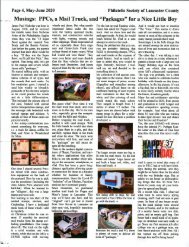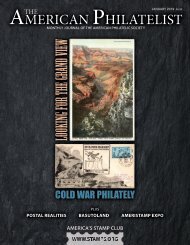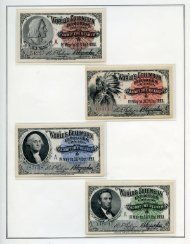February 2018 - Sneak Peek
The American Philatelist is the monthly journal of the American Philatelic Society, the world's largest organization for stamp collectors and enthusiasts. Members receive the printed magazine and can access the digital edition as a benefit of membership in the Society. Please enjoy this sneak peek. We're confident that once you see all that we offer, you'll want to join the APS today.
The American Philatelist is the monthly journal of the American Philatelic Society, the world's largest organization for stamp collectors and enthusiasts. Members receive the printed magazine and can access the digital edition as a benefit of membership in the Society. Please enjoy this sneak peek. We're confident that once you see all that we offer, you'll want to join the APS today.
Create successful ePaper yourself
Turn your PDF publications into a flip-book with our unique Google optimized e-Paper software.
same hand as whoever addressed the letter.<br />
Even without looking inside the envelopes, which I soon<br />
would, the story – with links to Alabama, Ohio and World<br />
War I – started to reveal itself.<br />
The covers were all postmarked between August 26, 1917<br />
and March 12, 1918. The first two carry a simple circular<br />
date cancel of Montgomery, Ala. The next five all incorporate<br />
“Sheridan Br.” or “Sheridan Branch” into the cancellation.<br />
The final two covers, posted in March 1918, return to<br />
the simpler “Montgomery, Ala” postmark.<br />
Poking around on the internet I was quickly able to figure<br />
out a bit more of the story.<br />
The online sources of the Encyclopedia<br />
of Alabama and Wikipedia offered<br />
the following information:<br />
Camp Sheridan, named for Civil<br />
War Union cavalry General Phil Sheridan,<br />
was established after the United<br />
States entered World War I in April<br />
1917. It was one of 16 U.S. Army National<br />
Guard mobilization and training<br />
camps established to train and integrate<br />
National Guard units for service<br />
in a U.S. Army division. (All National<br />
Guard units were activated.)<br />
Postcard depicting the “Tents of Commanding<br />
General and Staff. U.S. National Guard, Camp<br />
Sheridan, Montgomery, Ala." Photo from the<br />
Alabama Department of Archives and History.<br />
Camp Sheridan was built between July and November<br />
1917. Buildings included 313 mess halls, 314 bath houses<br />
and latrines, 40 warehouses, and 4,000 wooden-floored tents<br />
occupying 4,000 acres just northeast of downtown Montgomery.<br />
It was designed to hold 41,000 troops and quickly<br />
became home as the training ground for about 20,000 Ohio<br />
National Guardsmen who arrived between August and October<br />
1917.<br />
Before I checked out the philately I wanted to see what<br />
was inside these 100-year-old envelopes. All contain letters<br />
from a soldier in his late 20s who called himself “Dick.” Essentially,<br />
it’s a packet of love letters from a soldier, a member<br />
of the Ohio National Guard who was called up to train for<br />
active duty. The unit mostly filled what<br />
became the 135th Machine Gun Battalion,<br />
Company D, of the 37th Infantry<br />
Division – the Buckeye Division, which<br />
had an insignia of a red circle within a<br />
white border – and was sent overseas in<br />
June 1918. Our letter-writer, Dick, was<br />
part of that division’s 135th Machine<br />
Gun Battalion.<br />
All but one of the letters contains<br />
one sheet of paper folded to make three<br />
or four writing surfaces. One letter –<br />
FEBRUARY <strong>2018</strong> / AMERICAN PHILATELIST 133

















